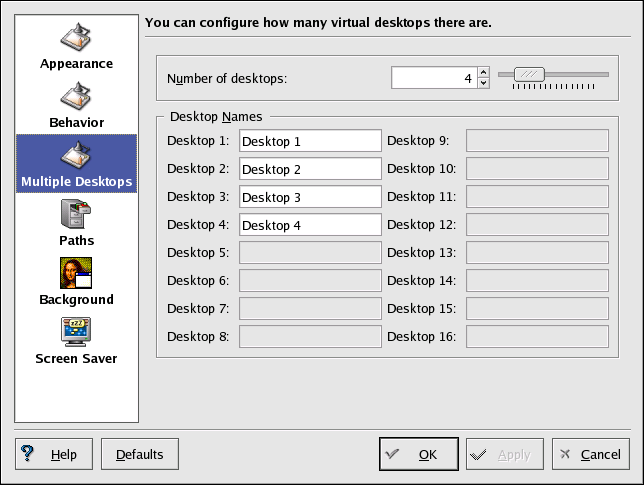A.4. Using The Panel
The panel stretches across the bottom of the desktop. By default, it contains the main menu icon and quick-launch icons for starting a Web browser, email client, word processor, and other commonly used applications.
The panel is highly configurable. You can add and remove buttons that launch applications easily. Right-click on the panel and select Configure Panel to open the panel Settings. You can configure panel orientation and size, set a panel hiding configuration (where the panel remains hidden until you hover over the panel area), and customize your main menu. Click Help at any time to learn more about configuring your panel.
Other tabs in Settings contain options to further customize your panel and taskbar. Click on Help for more information on these options.
Applications and utilities can be added easily to the panel. To add an application launcher to the panel, right-click on the panel and choose Add. Then select Application Button and make your choice from the menus.
A.4.1. Using The Main Menu
The Main Menu  is the central point for using KDE. Clicking on
the Main Menu icon on the panel displays a
large master menu from which you can perform tasks such as launch
applications, find files, and configure your desktop. The main menu
also contains several submenus that organize applications and tools
into several categories, including
Graphics,
Internet,
Office, Games,
and more.
is the central point for using KDE. Clicking on
the Main Menu icon on the panel displays a
large master menu from which you can perform tasks such as launch
applications, find files, and configure your desktop. The main menu
also contains several submenus that organize applications and tools
into several categories, including
Graphics,
Internet,
Office, Games,
and more.
From the Main Menu, you can lock your screen, which displays a password-protected screensaver. You can also run applications from a command line as well as logout of your KDE session.
A.4.2. Using Applets
Applets are small applications that run on the panel. There are several types of applets performing functions such as system monitoring, time and date display, and launching applications by typing commands in a text box.
There are some applets that run on the panel by default. This section covers them in detail.
A.4.2.1. Working with Multiple Desktops
By default, KDE provides four desktops that you can use to display multiple applications without having to crowd all of them onto one desktop. Each desktop can hold icons, open applications, and be individually customized.
For example, while you are writing a message in Evolution on desktop one, you can have Mozilla browsing the Web on desktop two, the OpenOffice.org Writer word processor open on desktop three, and so on.
You can change the number and names of desktops available in KDE by making these adjustments:
Right-click on the desktop; a brief menu of actions is displayed.
Select Configure Desktop; the KDE desktop configuration tool is displayed.
Click the Multiple Desktops icon (see Figure A-5).
You can change the names of your desktops (from Desktop 1, Desktop 2, etc.) by deleting the default names and typing a new name in each desktop's corresponding text box.
You can also change the number of desktops available to you by adjusting the slider in the Number of Desktops. For more desktops, drag the bar to the right; for fewer desktops, drag the bar to the left.
The Appearance, Behavior, and Paths, and Background icons are where you can make various desktop configuration changes. For example, to customize each virtual desktop to have different backgrounds, click the Background icon, uncheck the Common Background checkbox, click the virtual desktop you want to change, and choose the color or image you want to make your background using the associated tabs.
After you make any adjustments to your desktop configuration, click Apply to save the changes. Click OK to close the desktop configuration tool.
Buttons for your desktops appear on the panel in the Desktop Pager. Click on a tile to move to a different desktop.
 | Tip |
|---|---|
You can use the keyboard combination of the
|
A.4.2.2. Viewing The Taskbar
The taskbar displays all running applications, both minimized and displayed, on all desktops.
You can maximize running applications or bring them to the front of your working windows by clicking on the associated item on the taskbar.
 | Tip |
|---|---|
Another way to bring minimized or background windows to the
front is to use the |
A.4.3. Adding Icons and Applets to the Panel
To further customize the panel for your particular needs, you can include additional launcher icons to start applications without using the main menu or Start Here.
To add a new launcher to the panel, right-click the panel and choose Add => Application Button and choose the application or resource you wish to add to the panel. This automatically adds an icon on the panel. You can move the icon anywhere you want on the panel by right-clicking the icon and choosing Move Application Button, where Application is the name of the application associated with the icon.
A.4.4. Configuring the KDE Panel
You can hide the panel automatically or manually, place it on any edge of your desktop, change its size and color, and change the way it behaves. To alter the default panel settings, right-click the panel and choose Configure Panel. The Settings window appears, allowing you to adjust all panel settings, or any one of the specific properties (Arrangement, Hiding, Menus, and so on). Choose the Hiding tab, click Hide automatically, and adjust the number of seconds to elapse before the panel is hidden. Click Apply then OK to close the Settings dialog. The panel remains hidden until you hover over the panel area to make it reappear.




